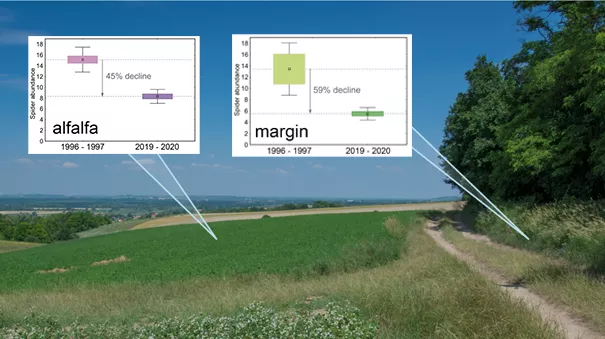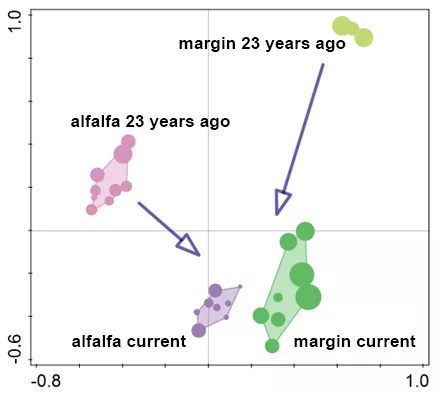Researchers from the Centre for Agricultural Research (ATK) and the Centre for Ecological Research (CER), both belonging to ELKH, studied long-term changes in spider populations that play a beneficial role in agriculture by repeating a two-year study from 23 years ago. Comparing the results of the studies showed a significant decrease in population numbers, averaging about 50 percent, over the nearly quarter-century period in agricultural areas. Despite the minimal change in total species number, populations of previously common farmland species showed a drastic decline. The paper presenting what is a unique comprehensive study on spiders appeared in the prestigious Scientific Reports journal.
Six years ago, a German research shocked the public by showing that it is no coincidence that car windows need to be cleaned less often on long journeys, as the number of flying insects had decreased by 75% over 27 years in protected areas in Germany. Unfortunately, the reality of the so-called "insect apocalypse" has been confirmed by several other studies. Insects and other arthropods play a key role in the functioning of the terrestrial biosphere due to their enormous biomass and species diversity. Through various ecosystem services they also ensure the survival of humanity; we just need to think of pollinating insects or the role of arthropods in decomposition and soil formation. However, despite the importance of the topic, researchers' knowledge has remained patchy. Previous research has focused on a few common, more spectacular insect groups and has often come to conflicting results regarding the causes, such as whether global climate and land use changes or rather local factors, including intensive pesticide use and habitat transformation, are the cause.
The research group led by Ferenc Samu of the Plant Protection Institute (NÖVI) at ATK with the involvement of colleagues from the Lendület Landscape and Conservation Ecology Research Group at CER studied long-term changes in spider populations. Spiders play a beneficial role in agriculture as they are important natural enemies of several insect pests in various crops. Compared to insects, population trends in spiders are under-researched worldwide and with this group it also needs clarification whether changes can be attributed to global climate change or to transformations in the local environment. To clarify these points the researchers replicated a two-year spider study from 23 years ago on an alfalfa field untreated with pesticides and its grassy border, attempting to eliminate the effects of local changes. They reproduced the protocol used at that time in terms of the collection period, methods, and sampling efforts.

Figure 1. Decrease in spider populations in an alfalfa field and its grassy border
(Photo: Attila Lengyel)
The comparison of the results of the studies showed a significant decrease in spider populations: they found 45 percent fewer spider individuals in the alfalfa and 59 percent fewer in the natural grassy edge surrounding the field. However, in terms of species diversity, they only observed a minimal decrease, rather a replacement of certain species and the decimation of the populations of many common farmland species. As a result of this process, the previously distinct spider communities in semi-natural and agricultural habitats have become more similar, indicating a decrease in overall diversity, especially among the web-building agricultural spider species. The study not only draws attention to the danger of the decline of beneficial spiders, but also points out that the phenomenon cannot be attributed to possible local changes alone, but we are facing an imprint of larger-scale processes. Although the general problem of climate change, intensive land use, and the retreat of nature is well known, this study provides further evidence that urgent action is needed to stop these unfavorable processes.

Figure 2. The spider species composition of the semi-natural margin and the alfalfa field, which were well separated 23 years ago, have now become noticeably more similar to each other.
Publication:
Samu, F., Szita, É., Botos, E., Simon, J., Gallé-Szpisjak, N. & Gallé, R. (2023). Agricultural spider decline: long-term trends under constant management conditions. Scientific Reports 13: 2305. DOI: 10.1038/s41598-023-29003-2